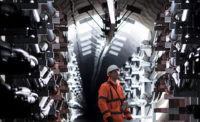As the U.K. begins to fast-track nuclear power permitting, its safety regulator and those of Finland and France have sent Europe’s main nuclear plant supplier back to the drawing board. Already grappling with construction delays at its first EPR pressurized water reactor project—Finland’s Olkiluoto 3 (OL3) plant—Areva Np., Paris, must now also rethink key safety systems. In an unusual joint move, nuclear safety regulators in the U.K., Finland and France recently revealed safety concerns about the EPR’s control and instrumentation (C&I) systems.

“The EPR design, as originally proposed...doesn’t comply with the independence principle, as there is a very high degree of complex interconnectivity between the control and safety systems,” report officials at the U.K. Health & Safety Executive.
Delays in developing the C&I system to the satisfaction of STUK, Finland’s regulatory agency, “may become critical for the plant’s time schedule,” claims Jouni Silvennoinen, project director with OL3’s owner, Teollisuuden Voima Oy (TVO), Helsinki.
However, Areva has already responded to STUK’s request for information, counters a company spokeswoman. Any modifications needed to deal with the Finnish regulator’s concerns would be minor, she adds. “The safety of the EPR reactor has absolutely not been called into question,” says the spokeswoman.
TVO’s turnkey consortium of Areva and Germany’s Siemens A.G., Erlangen, are in dispute over causes of the OL3 project’s delay. The 1,600-MW reactor building reached roof height this month. But TVO forecasts the plant’s start-up may come later than the much extended June 2012 deadline.
When signed in December 2003, the contract’s completion was scheduled for this year. Silvennoinen cites civil-construction snags as a cause of delay. But late last year Areva/Siemens launched arbitration proceedings at the International Chamber of Commerce, Paris, citing time taken by TVO to approve documentation.
For safety concerns in the other two countries, Areva aims to deal by year’s end with questions from the French regulator ASN. Areva, with French electricity generator EDF S.A., is adapting designs to local standards for possibly four reactors in the U.K..
EPR designs for each country differ slightly but “issues we raised with the current C&I system are broadly similar,” notes a U.K. health and safety official. “As designs are similar, it is likely that the solution will be similar, although not necessarily identical.”
The Health & Safety Executive is now undertaking so-called Generic Design Assessment to deal with potential problems at the design stage of the two reactor types—the EPR and the Westinghouse-Toshiba AP1000 PWR—competing for the U.K. market.
In parallel, the U.K. government this month identified 10 existing nuclear sites for potential development. Aiming to get nuclear power on stream in the next decade, the government is now introducing a new permitting procedure for all kinds of major infrastructure projects.
Energy and Climate Secretary Ed Miliband recently issued new draft National Policy Statements. Open for comment until early next year, the final statements will form the basis of planning decisions made by the new Infrastructure Planning Commission beginning in March.
The government hopes to shorten the planning process by taking the debate over the desirability of nuclear power out of public comment for individual projects. The last U.K. nuclear project, Sizewell B, took six years to secure planning consent at a cost of $50 million, reports an official.
Among the planning commission’s first five projects of various kinds are proposals by EDF for plants at Hinkley Point, Somerset, and Sizewell, Suffolk.
Areva already has an EPR under construction in France and two in China. Including the four in U.K., the company hopes to sell another 14 around the globe. Eight are planned for the U.S., four for Italy and two for India.
The U.S. EPR is a version of the European EPR that has been adapted for the U.S. market. “The U.S. EPR design has a different instrumentation and control system than the EPR units being constructed in Europe. These concerns are not applicable to the U.S. EPR design,” says Lori Vidil Dries, spokeswoman for UniStar Nuclear Energy, Baltimore, the company developing the reactor�s market.


